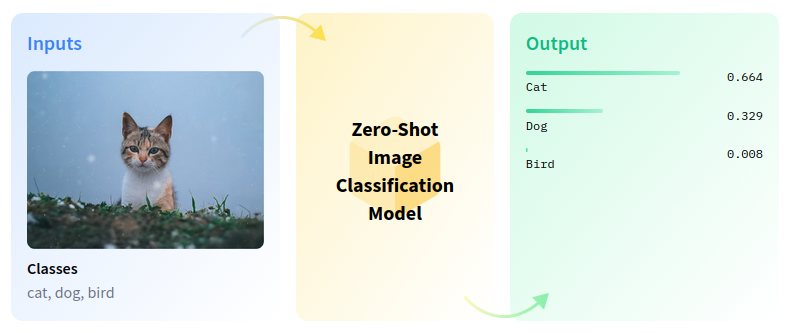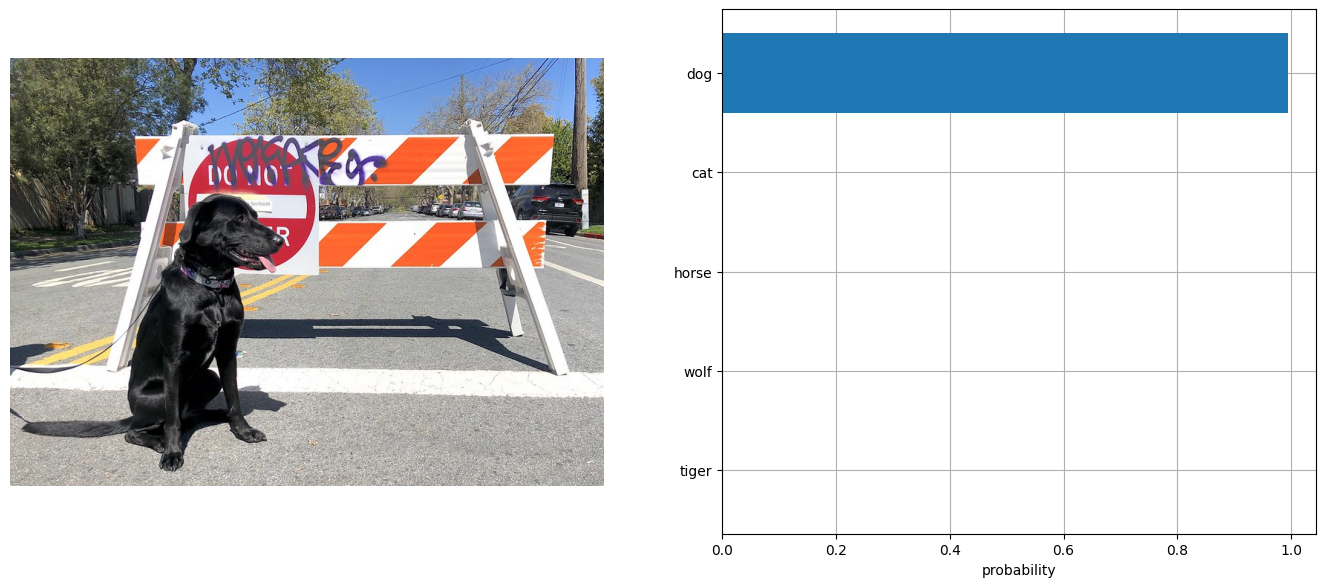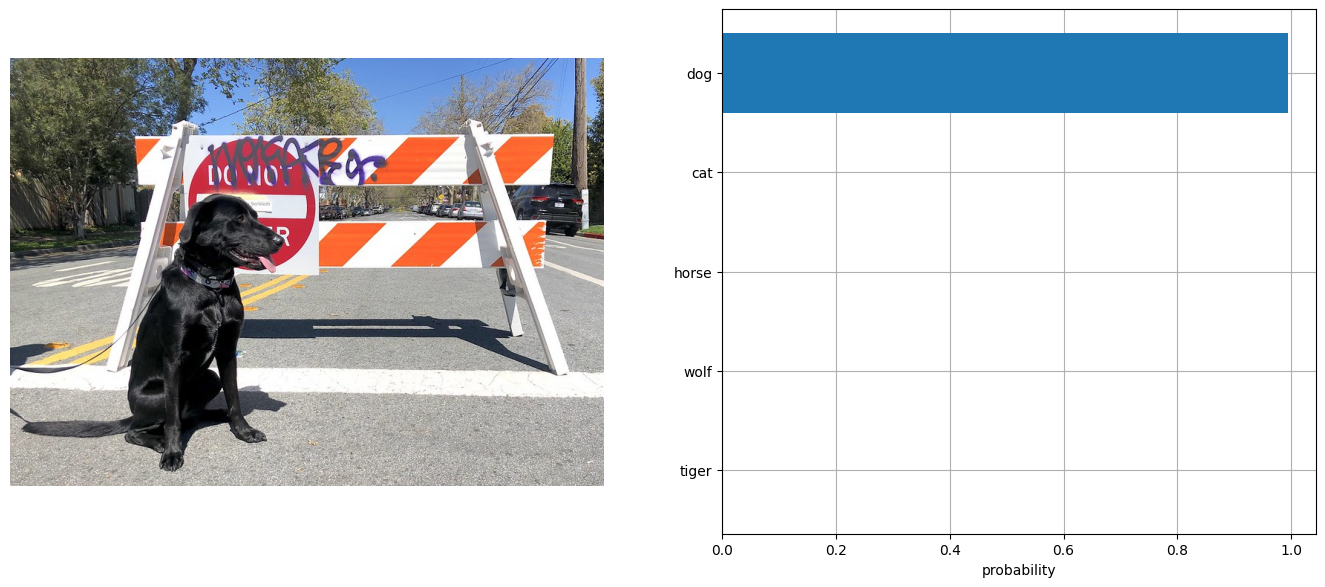Zero-shot Image Classification with SigLIP¶
This Jupyter notebook can be launched on-line, opening an interactive environment in a browser window. You can also make a local installation. Choose one of the following options:
Zero-shot image classification is a computer vision task to classify images into one of several classes without any prior training or knowledge of the classes.

zero-shot-pipeline¶
Zero-shot learning resolves several challenges in image retrieval systems. For example, with the rapid growth of categories on the web, it is challenging to index images based on unseen categories. We can associate unseen categories to images with zero-shot learning by exploiting attributes to model’s relationship between visual features and labels. In this tutorial, we will use the SigLIP model to perform zero-shot image classification.
Table of contents:¶
Instantiate model¶
The SigLIP model was proposed in Sigmoid Loss for Language Image Pre-Training. SigLIP proposes to replace the loss function used in CLIP (Contrastive Language–Image Pre-training) by a simple pairwise sigmoid loss. This results in better performance in terms of zero-shot classification accuracy on ImageNet.
The abstract from the paper is the following:
We propose a simple pairwise Sigmoid loss for Language-Image Pre-training (SigLIP). Unlike standard contrastive learning with softmax normalization, the sigmoid loss operates solely on image-text pairs and does not require a global view of the pairwise similarities for normalization. The sigmoid loss simultaneously allows further scaling up the batch size, while also performing better at smaller batch sizes.
You can find more information about this model in the research paper, GitHub repository, Hugging Face model page.
In this notebook, we will use google/siglip-base-patch16-224, available via Hugging Face Transformers, but the same steps are applicable for other CLIP family models.
First, we need to create AutoModel class object and initialize it
with model configuration and weights, using from_pretrained method.
The model will be automatically downloaded from Hugging Face Hub and
cached for the next usage. AutoProcessor class is a wrapper for
input data preprocessing. It includes both encoding the text using
tokenizer and preparing the images.
%pip install -q --extra-index-url https://download.pytorch.org/whl/cpu gradio "openvino>=2023.3.0" "transformers[torch]>=4.37" sentencepiece protobuf scipy datasets nncf
DEPRECATION: pytorch-lightning 1.6.5 has a non-standard dependency specifier torch>=1.8.*. pip 24.1 will enforce this behaviour change. A possible replacement is to upgrade to a newer version of pytorch-lightning or contact the author to suggest that they release a version with a conforming dependency specifiers. Discussion can be found at https://github.com/pypa/pip/issues/12063
Note: you may need to restart the kernel to use updated packages.
from transformers import AutoProcessor, AutoModel
model = AutoModel.from_pretrained("google/siglip-base-patch16-224")
processor = AutoProcessor.from_pretrained("google/siglip-base-patch16-224")
2024-02-10 00:51:12.979353: I tensorflow/core/util/port.cc:110] oneDNN custom operations are on. You may see slightly different numerical results due to floating-point round-off errors from different computation orders. To turn them off, set the environment variable TF_ENABLE_ONEDNN_OPTS=0. 2024-02-10 00:51:13.014583: I tensorflow/core/platform/cpu_feature_guard.cc:182] This TensorFlow binary is optimized to use available CPU instructions in performance-critical operations. To enable the following instructions: AVX2 AVX512F AVX512_VNNI FMA, in other operations, rebuild TensorFlow with the appropriate compiler flags.
2024-02-10 00:51:13.629829: W tensorflow/compiler/tf2tensorrt/utils/py_utils.cc:38] TF-TRT Warning: Could not find TensorRT
Run PyTorch model inference¶
To perform classification, define labels and load an image in RGB
format. To give the model wider text context and improve guidance, we
extend the labels description using the template “This is a photo of a”.
Both the list of label descriptions and image should be passed through
the processor to obtain a dictionary with input data in the
model-specific format. The model predicts an image-text similarity score
in raw logits format, which can be normalized to the [0, 1] range
using the softmax function. Then, we select labels with the highest
similarity score for the final result.
# Results visualization function
from typing import List
import matplotlib.pyplot as plt
import numpy as np
from PIL import Image
def visualize_result(image: Image, labels: List[str], probs: np.ndarray, top: int = 5):
"""
Utility function for visualization classification results
params:
image: input image
labels: list of classification labels
probs: model predicted softmaxed probabilities for each label
top: number of the highest probability results for visualization
returns:
None
"""
plt.figure(figsize=(72, 64))
top_labels = np.argsort(-probs)[: min(top, probs.shape[0])]
top_probs = probs[top_labels]
plt.subplot(8, 8, 1)
plt.imshow(image)
plt.axis("off")
plt.subplot(8, 8, 2)
y = np.arange(top_probs.shape[-1])
plt.grid()
plt.barh(y, top_probs)
plt.gca().invert_yaxis()
plt.gca().set_axisbelow(True)
plt.yticks(y, [labels[index] for index in top_labels])
plt.xlabel("probability")
print([{labels[x]: round(y, 2)} for x, y in zip(top_labels, top_probs)])
from urllib.request import urlretrieve
from pathlib import Path
import torch
from PIL import Image
image_path = Path("test_image.jpg")
urlretrieve(
"https://storage.openvinotoolkit.org/repositories/openvino_notebooks/data/data/image/coco.jpg",
image_path,
)
image = Image.open(image_path)
input_labels = ['cat', 'dog', 'wolf', 'tiger', 'man', 'horse', 'frog', 'tree', 'house', 'computer']
text_descriptions = [f"This is a photo of a {label}" for label in input_labels]
inputs = processor(text=text_descriptions, images=[image], padding="max_length", return_tensors="pt")
with torch.no_grad():
model.config.torchscript = False
results = model(**inputs)
logits_per_image = results['logits_per_image'] # this is the image-text similarity score
probs = logits_per_image.softmax(dim=1).detach().numpy()
visualize_result(image, input_labels, probs[0])
[{'dog': 0.99}, {'cat': 0.0}, {'horse': 0.0}, {'wolf': 0.0}, {'tiger': 0.0}]

Convert model to OpenVINO Intermediate Representation (IR) format¶
For best results with OpenVINO, it is recommended to convert the model
to OpenVINO IR format. OpenVINO supports PyTorch via Model conversion
API. To convert the PyTorch model to OpenVINO IR format we will use
ov.convert_model of model conversion
API.
The ov.convert_model Python function returns an OpenVINO Model
object ready to load on the device and start making predictions.
import openvino as ov
model.config.torchscript = True
ov_model = ov.convert_model(model, example_input=dict(inputs))
WARNING:tensorflow:Please fix your imports. Module tensorflow.python.training.tracking.base has been moved to tensorflow.python.trackable.base. The old module will be deleted in version 2.11.
[ WARNING ] Please fix your imports. Module %s has been moved to %s. The old module will be deleted in version %s.
/opt/home/k8sworker/ci-ai/cibuilds/ov-notebook/OVNotebookOps-609/.workspace/scm/ov-notebook/.venv/lib/python3.8/site-packages/transformers/models/siglip/modeling_siglip.py:353: TracerWarning: Converting a tensor to a Python boolean might cause the trace to be incorrect. We can't record the data flow of Python values, so this value will be treated as a constant in the future. This means that the trace might not generalize to other inputs!
if attn_weights.size() != (batch_size, self.num_heads, q_len, k_v_seq_len):
/opt/home/k8sworker/ci-ai/cibuilds/ov-notebook/OVNotebookOps-609/.workspace/scm/ov-notebook/.venv/lib/python3.8/site-packages/transformers/models/siglip/modeling_siglip.py:371: TracerWarning: Converting a tensor to a Python boolean might cause the trace to be incorrect. We can't record the data flow of Python values, so this value will be treated as a constant in the future. This means that the trace might not generalize to other inputs!
if attn_output.size() != (batch_size, self.num_heads, q_len, self.head_dim):
Run OpenVINO model¶
The steps for making predictions with the OpenVINO SigLIP model are similar to the PyTorch model. Let us check the model result using the same input data from the example above with PyTorch.
Select device from dropdown list for running inference using OpenVINO
import ipywidgets as widgets
core = ov.Core()
device = widgets.Dropdown(
options=core.available_devices + ["AUTO"],
value='AUTO',
description='Device:',
disabled=False,
)
device
Dropdown(description='Device:', index=1, options=('CPU', 'AUTO'), value='AUTO')
Run OpenVINO model
from scipy.special import softmax
# compile model for loading on device
compiled_ov_model = core.compile_model(ov_model, device.value)
# obtain output tensor for getting predictions
logits_per_image_out = compiled_ov_model.output(0)
# run inference on preprocessed data and get image-text similarity score
ov_logits_per_image = compiled_ov_model(dict(inputs))[logits_per_image_out]
# perform softmax on score
probs = softmax(ov_logits_per_image[0])
# visualize prediction
visualize_result(image, input_labels, probs)
[{'dog': 0.99}, {'cat': 0.0}, {'horse': 0.0}, {'wolf': 0.0}, {'tiger': 0.0}]

Great! Looks like we got the same result.
Apply post-training quantization using NNCF¶
NNCF enables post-training quantization by adding the quantization layers into the model graph and then using a subset of the training dataset to initialize the parameters of these additional quantization layers. The framework is designed so that modifications to your original training code are minor. Quantization is the simplest scenario and requires a few modifications.
The optimization process contains the following steps:
Create a dataset for quantization.
Run
nncf.quantizefor getting a quantized model.
Prepare dataset¶
The Conceptual Captions dataset consisting of ~3.3M images annotated with captions is used to quantize model.
import requests
from io import BytesIO
from PIL import Image
from requests.packages.urllib3.exceptions import InsecureRequestWarning
requests.packages.urllib3.disable_warnings(InsecureRequestWarning)
def check_text_data(data):
"""
Check if the given data is text-based.
"""
if isinstance(data, str):
return True
if isinstance(data, list):
return all(isinstance(x, str) for x in data)
return False
def get_pil_from_url(url):
"""
Downloads and converts an image from a URL to a PIL Image object.
"""
response = requests.get(url, verify=False, timeout=20)
image = Image.open(BytesIO(response.content))
return image.convert("RGB")
def collate_fn(example, image_column="image_url", text_column="caption"):
"""
Preprocesses an example by loading and transforming image and text data.
Checks if the text data in the example is valid by calling the `check_text_data` function.
Downloads the image specified by the URL in the image_column by calling the `get_pil_from_url` function.
If there is any error during the download process, returns None.
Returns the preprocessed inputs with transformed image and text data.
"""
assert len(example) == 1
example = example[0]
if not check_text_data(example[text_column]):
raise ValueError("Text data is not valid")
url = example[image_column]
try:
image = get_pil_from_url(url)
h, w = image.size
if h == 1 or w == 1:
return None
except Exception:
return None
inputs = processor(text=example[text_column], images=[image], return_tensors="pt", padding="max_length")
if inputs['input_ids'].shape[1] > model.config.text_config.max_position_embeddings:
return None
return inputs
import torch
from datasets import load_dataset
from tqdm.notebook import tqdm
def prepare_calibration_data(dataloader, init_steps):
"""
This function prepares calibration data from a dataloader for a specified number of initialization steps.
It iterates over the dataloader, fetching batches and storing the relevant data.
"""
data = []
print(f"Fetching {init_steps} for the initialization...")
counter = 0
for batch in tqdm(dataloader):
if counter == init_steps:
break
if batch:
counter += 1
with torch.no_grad():
data.append(
{
"pixel_values": batch["pixel_values"].to("cpu"),
"input_ids": batch["input_ids"].to("cpu"),
}
)
return data
def prepare_dataset(opt_init_steps=300, max_train_samples=1000):
"""
Prepares a vision-text dataset for quantization.
"""
dataset = load_dataset("conceptual_captions", streaming=True)
train_dataset = dataset["train"].shuffle(seed=42, buffer_size=max_train_samples)
dataloader = torch.utils.data.DataLoader(train_dataset, collate_fn=collate_fn, batch_size=1)
calibration_data = prepare_calibration_data(dataloader, opt_init_steps)
return calibration_data
calibration_data = prepare_dataset()
/opt/home/k8sworker/ci-ai/cibuilds/ov-notebook/OVNotebookOps-609/.workspace/scm/ov-notebook/.venv/lib/python3.8/site-packages/datasets/load.py:1454: FutureWarning: The repository for conceptual_captions contains custom code which must be executed to correctly load the dataset. You can inspect the repository content at https://hf.co/datasets/conceptual_captions You can avoid this message in future by passing the argument trust_remote_code=True. Passing trust_remote_code=True will be mandatory to load this dataset from the next major release of datasets. warnings.warn(
Fetching 300 for the initialization...
0it [00:00, ?it/s]
Quantize model¶
Create a quantized model from the pre-trained FP16 model.
NOTE: Quantization is time and memory consuming operation. Running quantization code below may take a long time.
import nncf
import logging
nncf.set_log_level(logging.ERROR)
if len(calibration_data) == 0:
raise RuntimeError(
'Calibration dataset is empty. Please check internet connection and try to download images manually.'
)
calibration_dataset = nncf.Dataset(calibration_data)
quantized_ov_model = nncf.quantize(
model=ov_model,
calibration_dataset=calibration_dataset,
model_type=nncf.ModelType.TRANSFORMER,
)
INFO:nncf:NNCF initialized successfully. Supported frameworks detected: torch, tensorflow, onnx, openvino
Output()
NNCF also supports quantization-aware training, and other algorithms than quantization. See the NNCF documentation in the NNCF repository for more information.
Run quantized OpenVINO model¶
The steps for making predictions with the quantized OpenVINO SigLIP model are similar to the PyTorch model.
from scipy.special import softmax
input_labels = ['cat', 'dog', 'wolf', 'tiger', 'man', 'horse', 'frog', 'tree', 'house', 'computer']
text_descriptions = [f"This is a photo of a {label}" for label in input_labels]
inputs = processor(text=text_descriptions, images=[image], return_tensors="pt", padding="max_length")
compiled_int8_ov_model = ov.compile_model(quantized_ov_model)
logits_per_image_out = compiled_int8_ov_model.output(0)
ov_logits_per_image = compiled_int8_ov_model(dict(inputs))[logits_per_image_out]
probs = softmax(ov_logits_per_image, axis=1)
visualize_result(image, input_labels, probs[0])
[{'dog': 0.99}, {'cat': 0.0}, {'horse': 0.0}, {'frog': 0.0}, {'tiger': 0.0}]

Compare File Size¶
from pathlib import Path
fp16_model_path = 'siglip-base-patch16-224.xml'
ov.save_model(ov_model, fp16_model_path)
int8_model_path = 'siglip-base-patch16-224_int8.xml'
ov.save_model(quantized_ov_model, int8_model_path)
fp16_ir_model_size = Path(fp16_model_path).with_suffix(".bin").stat().st_size / 1024 / 1024
quantized_model_size = Path(int8_model_path).with_suffix(".bin").stat().st_size / 1024 / 1024
print(f"FP16 IR model size: {fp16_ir_model_size:.2f} MB")
print(f"INT8 model size: {quantized_model_size:.2f} MB")
print(f"Model compression rate: {fp16_ir_model_size / quantized_model_size:.3f}")
FP16 IR model size: 387.49 MB
INT8 model size: 196.46 MB
Model compression rate: 1.972
Compare inference time of the FP16 IR and quantized models¶
To measure the inference performance of the FP16 and INT8
models, we use median inference time on calibration dataset. So we can
approximately estimate the speed up of the dynamic quantized models.
NOTE: For the most accurate performance estimation, it is recommended to run
benchmark_appin a terminal/command prompt after closing other applications with static shapes.
import time
def calculate_inference_time(model_path, calibration_data):
model = ov.compile_model(model_path)
output_layer = model.output(0)
inference_time = []
for batch in calibration_data:
start = time.perf_counter()
_ = model(batch)[output_layer]
end = time.perf_counter()
delta = end - start
inference_time.append(delta)
return np.median(inference_time)
fp16_latency = calculate_inference_time(fp16_model_path, calibration_data)
int8_latency = calculate_inference_time(int8_model_path, calibration_data)
print(f"Performance speed up: {fp16_latency / int8_latency:.3f}")
Performance speed up: 1.982
Interactive inference¶
Now, it is your turn! You can provide your own image and comma-separated
list of labels for zero-shot classification. Feel free to upload an
image, using the file upload window and type label names into the text
field, using comma as the separator (for example, cat,dog,bird)
import gradio as gr
def classify(image, text):
"""Classify image using classes listing.
Args:
image (np.ndarray): image that needs to be classified in CHW format.
text (str): comma-separated list of class labels
Returns:
(dict): Mapping between class labels and class probabilities.
"""
labels = text.split(",")
text_descriptions = [f"This is a photo of a {label}" for label in labels]
inputs = processor(
text=text_descriptions,
images=[image],
return_tensors="np",
padding="max_length",
)
ov_logits_per_image = compiled_int8_ov_model(dict(inputs))[logits_per_image_out]
probs = softmax(ov_logits_per_image[0])
return {label: float(prob) for label, prob in zip(labels, probs)}
demo = gr.Interface(
classify,
[
gr.Image(label="Image", type="pil"),
gr.Textbox(label="Labels", info="Comma-separated list of class labels"),
],
gr.Label(label="Result"),
examples=[[image_path, "cat,dog,bird"]],
)
try:
demo.launch(debug=False, height=1000)
except Exception:
demo.launch(share=True, debug=False, height=1000)
# if you are launching remotely, specify server_name and server_port
# demo.launch(server_name='your server name', server_port='server port in int')
# Read more in the docs: https://gradio.app/docs/
Running on local URL: http://127.0.0.1:7860 To create a public link, set share=True in launch().